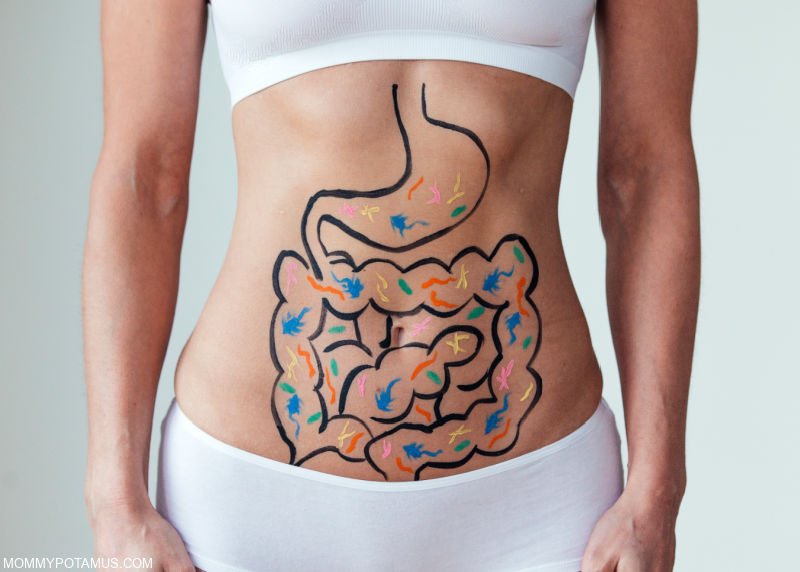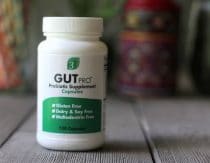
You are a wonder. Surprising. Amazing. Super. And by super, I mean superorganism. Scientists estimate that only about 50% of the cells in your body are human – the rest are microbial, and their genes influence your well-being just like yours do.
In fact, the microbes within you contain so much rich, synergistically interactive genetic material that they’re often called the “second genome.” And just like with rainforests and other ecosystems, diversity is a key biomarker of its resilience and vibrancy. (1)
Unfortunately, modern life has not been kind to our internal ecosystems. We eat fewer foods that have been fermented with beneficial bacteria and yeasts – yogurt, sauerkraut and kimchi, for example – and we’re exposed to countless antimicrobial agents over the course of our lives . . . childhood antibiotics, pesticides, harsh cleaning supplies, and more.
As The Human Microbiome Project– which was conducted by the National Institutes of Health- and other research continues to discover new benefits associated with a healthy internal ecosystem, many people have begun to turn to probiotics in order to increase both internal microbial richness (number of microbes) and diversity (types of microbes).
In this article we’ll dive into some of the research-backed benefits of probiotics, plus my top probiotic recommendation.
Before we dive into the details, though, I want to mention that none of these statements have been evaluated by the FDA, this article is not medical advice, and it is not meant to diagnose or treat any condition. As always, please talk with your healthcare provider about any supplements you are considering. Now that we’ve got that out of the way, let’s take a look at the research.
- Meet Your Microbiome, The “Second Genome”
- Why Bacteria Are (Mostly) Our Friends
- So, what exactly are probiotics and do they really work?
- 5 Benefits of Probiotics
- 1. Immune Support
- 2. They Make Nutrients & Other Beneficial Substances
- 3. Digestive Health
- 4. Skin Health
- 5. Heart Health
- Other Benefits
- Do probiotics have any side effects?
- Which Probiotic I Use (And Why)
- Want to try Seed’s Daily Synbiotic?
Meet Your Microbiome, The “Second Genome” ^
To get from the womb to the world, most babies make their way out through the birth canal. This is a big day for baby and microbiome alike, because unlike the womb, the birth canal is chock full of bacteria.” (2)
We get our first microbiome from our moms, either via the birth canal or via skin-to-skin contact and/or breastfeeding for babies who make their way into the world via caesarean section.
Like your first genome – you DNA – your microbiome is completely unique to you. However unlike your DNA, your microbiome is constantly changing. (As an aside, we can’t change our DNA but our lifestyle choices influence how our DNA is expressed. If you think of DNA as a piano, it’s lifestyle that plays the music.)
But back to your second genome. In addition to having a gut microbiome, you also have a skin microbiome, bladder microbiome, and other biomes that are unique to specific organs.
Most of your internal ecosystem lives in your digestive tract, though, and it’s strongly influenced by how much fiber you eat, what your stress levels are, how well you’re sleeping, and other factors. And contrary to what many of us have been told, not all the good guys set up camp and live there . . . some are more like travelers that are just passing through, yet still manage to do important work while they visit.
That, of course, brings us to . . .

Why Bacteria Are (Mostly) Our Friends ^
In a world with seeming non-stop food recalls due to E. coli and other contaminants, it’s easy to think that bacteria are more foe than friend.
In reality, though pathogenic strains make up less than 1% of all bacteria on earth. (3) The remaining 99% are either harmless or helpful . . . and by helpful I mean vital.
Our microbiome contributes “more genes responsible for human survival than humans contribute,” says a report from the Human Microbiome Project. (4)
They add that “This bacterial genomic contribution is critical for human survival. Genes carried by bacteria in the gastrointestinal tract, for example, allow humans to digest foods and absorb nutrients that otherwise would be unavailable.”
These symbiotic microbes – and probiotics that contain research-backed strains – do more than just affect gut health, though. They have systemic benefits that go far beyond.
So, what exactly are probiotics and do they really work? ^
According to the World Health Organization, probiotics are “Live microorganisms that, when administered in adequate amounts, confer a health benefit on the host.” (5)
Seems simple, right? Not exactly. Let’s break it down.
Survivability
Although all good bacteria (and sometimes beneficial yeasts such as Saccharomyces boulardii) are alive when they start their journey in the manufacturing plant, what matters is how many are still alive when they reach your gut. They have to survive the trip to to your home, then the harsh environment of your stomach in order to get to your gut.
Some probiotics are encapsulated in ways that increase viability, which means they deliver more live microorganisms.
Potency
If you’ve ever seen something like “30 billion CFU” on a probiotic label and wondered what it stands for, the answer is colony forming units. Basically, CFU describes how many active, living microorganisms are found in each serving of the probiotic.
Different probiotic strains have different therapeutic ranges, or CFU dosages that have been found in clinical studies to be effective. More is not always better, so it’s best to go with the amount that was determined to be optimal via studies.
Also, as mentioned above, just because a probiotic has a certain CFU at the beginning of manufacturing does not mean that the product has high viability (the ability to survive stomach acid), so it’s important to consider both potency and survivability.
In the future you’ll probably see more probiotics labeled with AFUs (Active Fluorescent Units) alongside or instead of CFUs. AFU is a more accurate way to measure potency, but because most clinical studies have used CFUs they’re usually what you’ll find on product labels.
Health Benefits
While 99% of microbes are either harmless or helpful, it’s the helpful ones we want in our probiotics, right? Unfortunately, in the U.S., many probiotics just list lactobacillus or bifidobacterium on the label without specifying which specific strain is included.
That’s a problem, because strain absolutely matters. Lactobacillus, for example, is actually a genus that contains hundreds of strains, and human clinical trials have found that different strains have different health benefits.
Also, remember when we talked about all those E. coli food recalls earlier? The specific strain associated with those recalls is 0157: NH, which can cause serious illness. However, there’s another member of the E. coli family – a strain called Nissle 1917 – that is used therapeutically for gastrointestinal issues.
Same genus, very different strains.
When choosing a probiotic, look for specific strains that have been shown to have benefits in human trials.
I’ll share more about the one my husband and I take at the bottom of this article, but first let’s take a look at some of the benefits probiotics have to offer.

5 Benefits of Probiotics ^
While most of your microbiome lives in your digestive system, your gut microbes have far-reaching effects throughout your whole body. They influence everything from immune and metabolic function to cardiovascular health, skin health and more.
Here are some of the top research-backed benefits:
1. Immune Support ^
Probiotics benefit the immune system in many ways, such as:
Supporting innate immunity, which “involves barriers that keep harmful materials from entering your body. These barriers form the first line of defense in the immune response.” (6)
Certain probiotic strains produce metabolites like butyrate, which is a short-chain fatty acid (SCFA) that strengthens the mucosal barrier lining of your intestines. (7) (8) A stronger gut barrier means better containment of pathogens.
Competing with pathogens for food. According to this analysis published in the Annals of Nutrition and Metabolism, “Probiotics compete for nutrients for growth and proliferation that would otherwise be utilized by pathogens.” (9)
Directly interacting with our immune cells. Through this interaction certain strains are thought to support our adaptive immune system, which is the part of the immune system that can adapt to a specific threat and then remember it in the future if you encounter it again.
As one study put it, “the adaptive immune system is profoundly shaped by the presence of the commensal intestinal microbiota.” (9)
2. They Make Nutrients & Other Beneficial Substances ^
We all know that probiotics help us digest our food better (more on that below), but did you know they can actually make nutrients for us? For example, this study found that three Bifidobacterium strains – adolescentis DSM 18350, B. adolescentis DSM 18352, and Bifidobacterium pseudocatenulatum DSM 18353 – actually make folate inside of our bodies.
Also known as vitamin B9, folate is needed to make red blood cells that carry oxygen around our body, convert carbohydrates into energy, produce DNA and RNA, and other things. We can get it by eating lots of dark, leafy greens, sprouts, liver and other folate rich foods . . . and by letting our bacteria make it for us, of course.
The probiotic I use contains two strains that have been found to increase folate production within the body – Limosilactobacillus reuteri SD-LRE2-IT and Bifidobacterium adolescentis SD-BA5-IT (DSM18352).
Folate is just one of the many beneficial substances that probiotics can make, though – other strains can make vitamin K2 and other nutrients such as B12. Also, as I mentioned in the section above, when probiotics interact with prebiotics (their food), they produce metabolites like butyrate which support gut barrier function and nutrient absorption.
3. Digestive Health ^
Signs of poor digestion include diarrhea, gas, bloating, stomach discomfort, and infrequent bowel movements. If that sounds familiar, you’re not alone. In this large study, 61% of Americans reported experiencing some sort of gastrointestinal discomfort – diarrhea, gas, bloating, stomach pain, or infrequent bowel movements – within the past week.
Our gut bacteria play a vital role in digestion. In fact, according to the Human Microbiome Project, they’re:
critical for human survival. Genes carried by bacteria in the gastrointestinal tract, for example, allow humans to digest foods and absorb nutrients that otherwise would be unavailable.”
‘Humans don’t have all the enzymes we need to digest our own diet, said Lita Proctor, Ph.D., NHGRI’s HMP program manager. ‘Microbes in the gut break down many of the proteins, lipids and carbohydrates in our diet into nutrients that we can then absorb. Moreover, the microbes produce beneficial compounds, like vitamins and anti-inflammatories that our genome cannot produce.’” (4)
Certain strains of probiotics – Lactobacillus plantarum SD-LP1-IT and Bifidobacterium breve SD-BR3-IT, for example – have been found in clinical trials to help with intestinal discomfort, bowel movement regularity, bloating, and more. (10)
The probiotic my husband and I take use both of these strains (more details below).
4. Skin Health ^
Just like probiotics have a positive effect on our gut barrier, certain strains have a positive impact on our skin barrier. (11)
A strong skin barrier helps cells hold onto water, which contributes to healthy, well-hydrated skin. Some strains are also associated with skin clarity and smoothness. (12)
5. Heart Health ^
Studies suggest certain probiotic strains have a positive influence on biomarkers of cardiovascular health such as blood lipid levels (HDL and LDL cholesterol). (13)
They may also have a beneficial impact on blood pressure, but more research is needed to confirm or rule out this effect. (14)
Other Benefits ^
Researchers have found that probiotic supplements can be beneficial in other ways, too, such as:
- Supporting urinary tract health – In women, both Lactobacillus rhamnosus GR-1 and L. reuteri RC-14 (previously called L. fermentum RC-14) have been found to be helpful for this purpose.
- Promoting tissue healing (15)
- Helping to promote a healthy inflammatory response (16)
Do probiotics have any side effects? ^
Probiotics are generally considered safe and well tolerated when taken as directed. However, mild stomach upset, diarrhea, or gas and bloating are sometimes reported, often within the first few days of taking them.
Common allergens such as dairy, soy, and egg are used as ingredients in some probiotics, which may trigger reactions in some people. If this is a concern, look for a dairy-free, soy-free, and/or egg-free option. Also, some people – such as those who have a weakened immune system or recently underwent surgery – may need to use extra caution.
If you have any questions about whether a probiotic is appropriate for your specific situation, please speak with your doctor.

Which Probiotic I Use (And Why) ^
My husband and I both use Seed Synbiotic, which is a 2-in-1 prebiotic and probiotic. (Probiotic + Prebiotic = Synbiotic)
Here’s why Seed is my top choice:
- Transparency – Because strain matters, and so does potency, Seed publishes exactly what strains are included and uses the same dosage range that has been shown to deliver a benefit in human studies. Here’s what their blend includes:
- Digestive Health, Gastrointestinal Immunity & Gut Barrier Integrity Blend (17 research-backed strains)
- Dermatological Health Blend (5 research-backed strains)
- Cardiovascular Health Blend (3 research-backed strains)
- Micronutrient Synthesis Blend (2 research-backed strains)
- Microbiota-Accessible Prebiotic™ [MAP] Blend (prebiotics)
- Survivability – Seed uses nested capsules that are designed to survive the harsh environment of the stomach. Basically, there’s an inner capsule with beneficial bacteria that is nested inside an outer capsule filled with a powdered prebiotic made from pomegranate that shields the bacteria from oxygen, moisture, heat, and stomach acid.
- Allergen-Free – It’s free of common allergens like dairy, gluten, and soy.
- Seed’s Chief Scientist, Dr. Gregor Reid, is literally the guy who coined the word “probiotic.” – In addition, their Scientific Advisory Board is made up of scientists, researchers, doctors and authors across the fields of microbiology, immunology, genetics, metabolomics, gastroenterology, pediatrics, molecular biology, and transcriptomics. They lead labs, teach at world-renowned academic institutions, and have among them 2800+ publications and over 140,000 citations in peer-reviewed scientific journals and textbooks.
Because probiotics work best when taken regularly, Seed’s Daily Synbiotic is only available via a monthly subscription. However, if needed you can easily skip/reschedule a delivery or cancel if needed.
Want to try Seed’s Daily Synbiotic? ^
Click here and use MPSAVE15 for 15% off your first month.
Sources
1. Lozupone, Catherine et. al. (2012) Diversity, stability and resilience of the human gut microbiota
2. American Museum of Natural History. Building Your Microbiome from Birth
3. Nature Reviews: Microbiology (2011) Microbiology by numbers
4. National Institutes of Health (2012) NIH Human Microbiome Project defines normal bacterial makeup of the body
5. Mack, David (2005) Probiotics
6. U.S. National Library of Medicine. Immune Response
7. Dorrestein, Pieter et. al. (2014) Finding the Missing Links among Metabolites, Microbes, and the Host
8. Hu, Madeleine et. al. (2018) Policing the intestinal epithelial barrier: Innate immune functions of intraepithelial lymphocytes
9. Annals of Nutrition and Metabolism (2019) Beneficial Effects of Probiotic Consumption on the Immune System
10. Del Piano, Mario et. al. (2010) The use of probiotics in healthy volunteers with evacuation disorders and hard stools: a double-blind, randomized, placebo-controlled study
11. Philippe, David et. al. (2011) Oral Lactobacillus paracasei improves skin barrier function recovery and reduces local skin inflammation
12. Kober, Mary-Margaret and Bowe, Whitney (2015) The effect of probiotics on immune regulation, acne, and photoaging
13. Andrade, Sara and Borges, Numo (2009) Effect of fermented milk containing Lactobacillus acidophilus and Bifidobacterium longum on plasma lipids of women with normal or moderately elevated cholesterol
14. Johns Hopkins Medicine. The Power of Gut Bacteria and Probiotics for Heart Health
15. Tagliari, Elaine et. al. (2019) Effect of Probiotic Oral Administration On Skin Wound Healing In Rats
16. Lomax, AR and Calder, PC (2009) Probiotics, immune function, infection and inflammation: a review of the evidence from studies conducted in humans
Didari T, et. al. (2015) Effectiveness of probiotics in irritable bowel syndrome: Updated systematic review with meta-analysis.




